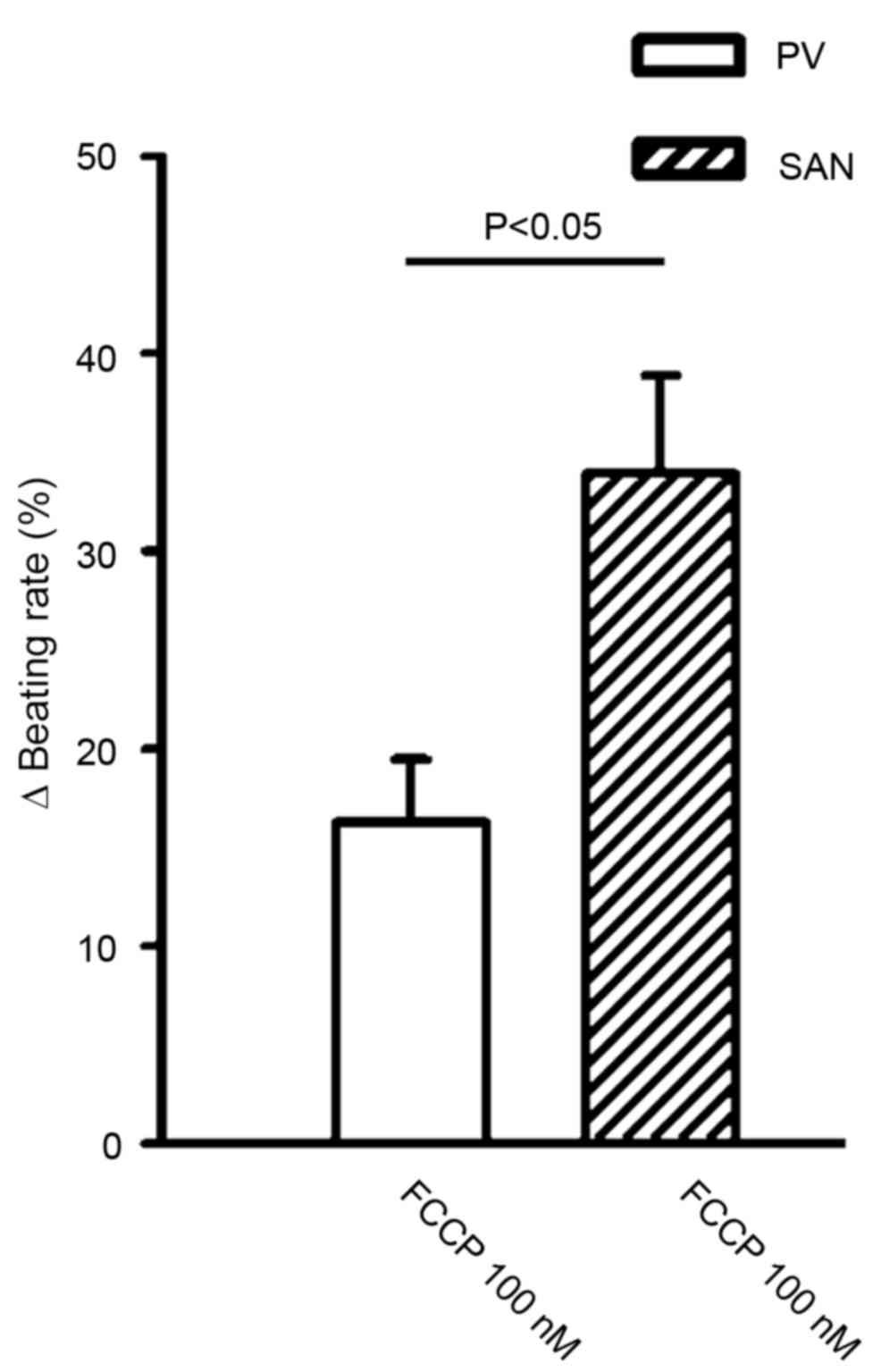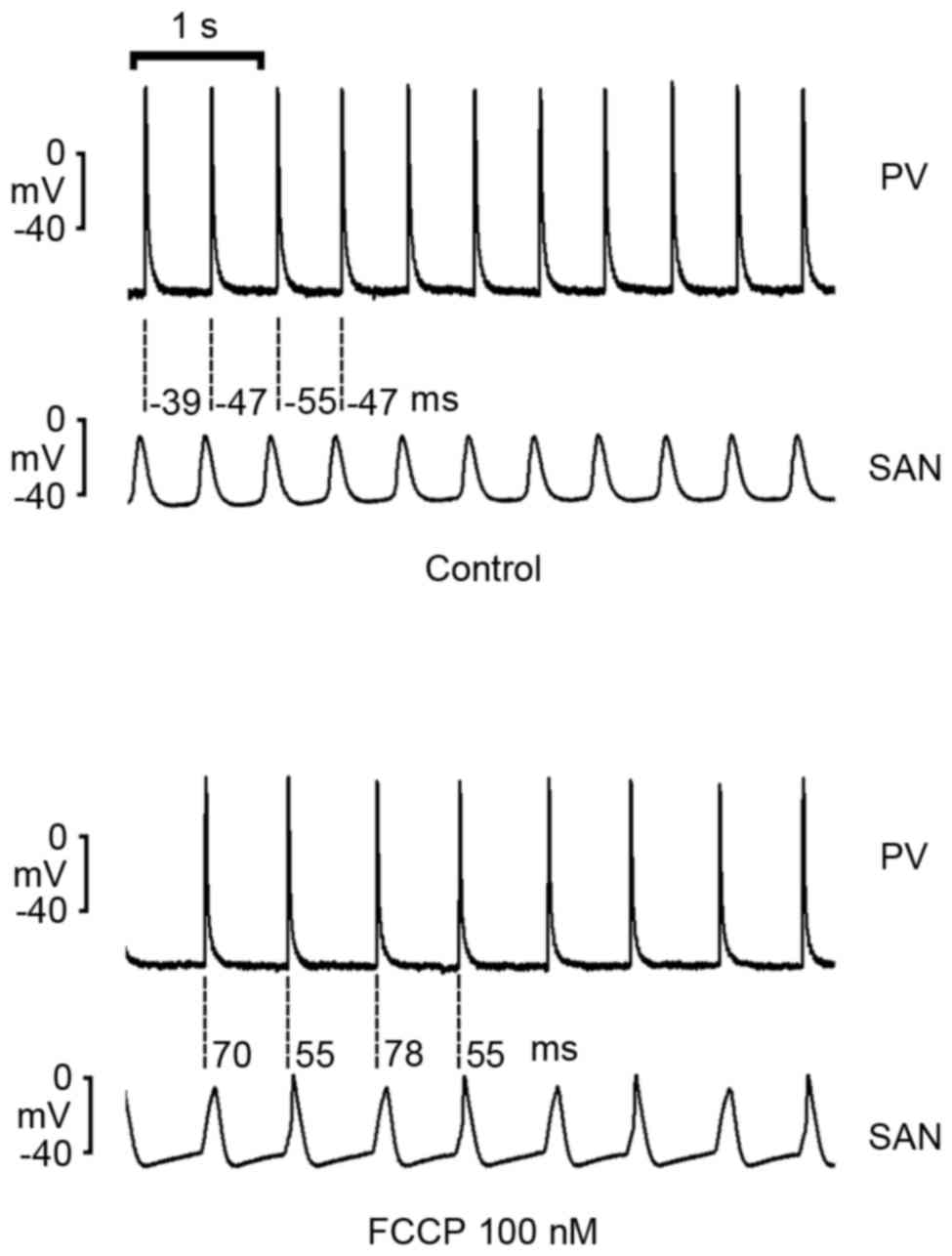|
1
|
Tsang TS and Gersh BJ: Atrial
fibrillation: An old disease, a new epidemic. Am J Med.
113:432–435. 2002. View Article : Google Scholar : PubMed/NCBI
|
|
2
|
Lin YK, Lin FZ, Chen YC, Cheng CC, Lin CI,
Chen YJ and Chen SA: Oxidative stress on pulmonary vein and left
atrium arrhythmogenesis. Circ J. 74:1547–1556. 2010. View Article : Google Scholar : PubMed/NCBI
|
|
3
|
Mihm MJ, Yu F, Carnes CA, Reiser PJ,
McCarthy PM, Van Wagoner DR and Bauer JA: Impaired myofibrillar
energetics and oxidative injury during human atrial fibrillation.
Circulation. 104:174–180. 2001. View Article : Google Scholar : PubMed/NCBI
|
|
4
|
Wang X, Takeda S, Mochizuki S, Jindal R
and Dhalla NS: Mechanisms of hydrogen peroxide-induced increase in
intracellular calcium in cardiomyocytes. J Cardiovasc Pharmacol
Ther. 4:41–48. 1999. View Article : Google Scholar : PubMed/NCBI
|
|
5
|
Van Wagoner DR: Redox modulation of
cardiac electrical activity. J Cardiovasc Electrophysiol.
12:183–184. 2001. View Article : Google Scholar : PubMed/NCBI
|
|
6
|
Brown DA and O'Rourke B: Cardiac
mitochondria and arrhythmias. Cardiovasc Res. 88:241–249. 2010.
View Article : Google Scholar : PubMed/NCBI
|
|
7
|
Jeong EM, Liu M, Sturdy M, Gao G, Varghese
ST, Sovari AA and Dudley SC Jr.: Metabolic stress, reactive oxygen
species, and arrhythmia. J Mol Cell Cardiol. 52:454–463. 2012.
View Article : Google Scholar : PubMed/NCBI
|
|
8
|
Montaigne D, Marechal X, Lefebvre P,
Modine T, Fayad G, Dehondt H, Hurt C, Coisne A, Koussa M,
Remy-Jouet I, et al: Mitochondrial dysfunction as an arrhythmogenic
substrate: A translational proof-of-concept study in patients with
metabolic syndrome in whom post-operative atrial fibrillation
develops. J Am Coll Cardiol. 62:1466–1473. 2013. View Article : Google Scholar : PubMed/NCBI
|
|
9
|
Ozawa T: Genetic and functional changes in
mitochondria associated with aging. Physiol Rev. 77:425–464.
1997.PubMed/NCBI
|
|
10
|
Wei YH, Lu CY, Lee HC, Pang CY and Ma YS:
Oxidative damage and mutation to mitochondrial DNA and
age-dependent decline of mitochondrial respiratory function. Ann N
Y Acad Sci. 854:155–170. 1998. View Article : Google Scholar : PubMed/NCBI
|
|
11
|
Michikawa Y, Mazzucchelli F, Bresolin N,
Scarlato G and Attardi G: Aging-dependent large accumulation of
point mutations in the human mtDNA control region for replication.
Science. 286:774–779. 1999. View Article : Google Scholar : PubMed/NCBI
|
|
12
|
Wang CH, Wu SB, Wu YT and Wei YH:
Oxidative stress response elicited by mitochondrial dysfunction:
Implication in the pathophysiology of aging. Exp Biol Med
(Maywood). 238:450–460. 2013. View Article : Google Scholar : PubMed/NCBI
|
|
13
|
Yoshida H, Bao L, Kefaloyianni E, Taskin
E, Okorie U, Hong M, Dhar-Chowdhury P, Kaneko M and Coetzee WA:
AMP-activated protein kinase connects cellular energy metabolism to
KATP channel function. J Mol Cell Cardiol. 52:410–418. 2012.
View Article : Google Scholar : PubMed/NCBI
|
|
14
|
Sasaki N, Sato T, Marbán E and O'Rourke
B: ATP consumption by uncoupled mitochondria activates sarcolemmal
K(ATP) channels in cardiac myocytes. Am J Physiol Heart Circ
Physiol. 280:H1882–H1888. 2001.PubMed/NCBI
|
|
15
|
Liu M, Sanyal S, Gao G, Gurung IS, Zhu X,
Gaconnet G, Kerchner LJ, Shang LL, Huang CL, Grace A, et al:
Cardiac Na+ current regulation by pyridine nucleotides. Circ Res.
105:737–745. 2009. View Article : Google Scholar : PubMed/NCBI
|
|
16
|
Liu M, Liu H and Dudley SC Jr.: Reactive
oxygen species originating from mitochondria regulate the cardiac
sodium channel. Circ Res. 107:967–974. 2010. View Article : Google Scholar : PubMed/NCBI
|
|
17
|
Matejíková J1, Kucharská J, Pancza D and
Ravingerová T: The effect of antioxidant treatment and NOS
inhibition on the incidence of ischemia-induced arrhythmias in the
diabetic rat heart. Physiol Res. 57 Suppl 2:S55–S60.
2008.PubMed/NCBI
|
|
18
|
Zhao Q, Kebbati AH, Zhang Y, Tang Y,
Okello E and Huang C: Effect of coenzyme Q10 on the incidence of
atrial fibrillation in patients with heart failure. J Investig Med.
63:735–739. 2015. View Article : Google Scholar : PubMed/NCBI
|
|
19
|
Langsjoen PH and Langsjoen AM: Overview of
the use of CoQ10 in cardiovascular disease. Biofactors. 9:273–284.
1999. View Article : Google Scholar : PubMed/NCBI
|
|
20
|
Honjo H, Boyett MR, Niwa R, Inada S,
Yamamoto M, Mitsui K, Horiuchi T, Shibata N, Kamiya K and Kodama I:
Pacing-induced spontaneous activity in myocardial sleeves of
pulmonary veins after treatment with ryanodine. Circulation.
107:1937–1943. 2003. View Article : Google Scholar : PubMed/NCBI
|
|
21
|
Chen SA, Hsieh MH, Tai CT, Tsai CF,
Prakash VS, Yu WC, Hsu TL, Ding YA and Chang MS: Initiation of
atrial fibrillation by ectopic beats originating from the pulmonary
veins: Electrophysiological characteristics, pharmacological
responses, and effects of radiofrequency ablation. Circulation.
100:1879–1886. 1999. View Article : Google Scholar : PubMed/NCBI
|
|
22
|
Chen YJ, Chen SA, Chen YC, Yeh HI, Chan P,
Chang MS and Lin CI: Effects of rapid atrial pacing on the
arrhythmogenic activity of single cardiomyocytes from pulmonary
veins: Implication in initiation of atrial fibrillation.
Circulation. 104:2849–2854. 2001. View Article : Google Scholar : PubMed/NCBI
|
|
23
|
Chen YC, Lu YY, Cheng CC, Lin YK, Chen SA
and Chen YJ: Sinoatrial node electrical activity modulates
pulmonary vein arrhythmogenesis. Int J Cardiol. 173:447–452. 2014.
View Article : Google Scholar : PubMed/NCBI
|
|
24
|
Lin YK, Lai MS, Chen YC, Cheng CC, Huang
JH, Chen SA, Chen YJ and Lin CI: Hypoxia and reoxygenation modulate
the arrhythmogenic activity of the pulmonary vein and atrium. Clin
Sci (Lond). 122:121–132. 2012. View Article : Google Scholar : PubMed/NCBI
|
|
25
|
Senges J, Mizutani T, Pelzer D, Brachmann
J, Sonnhof U and Kübler W: Effect of hypoxia on the sinoatrial
node, atrium and atrioventricular node in the rabbit heart. Circ
Res. 44:856–863. 1979. View Article : Google Scholar : PubMed/NCBI
|
|
26
|
Luck JC and Engel TR: Dispersion of atrial
refractoriness in patients with sinus node dysfunction.
Circulation. 60:404–412. 1979. View Article : Google Scholar : PubMed/NCBI
|
|
27
|
Loomis TA and Krop S: Auricular
fibrillation induced and maintained in animals by acetylcholine or
vagal stimulation. Circ Res. 3:390–396. 1955. View Article : Google Scholar : PubMed/NCBI
|
|
28
|
Yoshikawa Y, Kano T, Higuchi M and Nishi
K: Effects of coenzyme Q10 on recovery of hypoxia-induced changes
in ATP and creatine phosphate contents of sinoatrial nodal cells of
the rabbit's heart after reoxygenation. Arch Int Pharmacodyn Ther.
287:96–108S. 1987.PubMed/NCBI
|
















